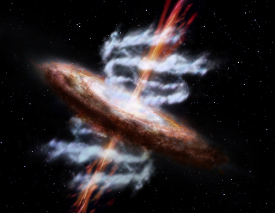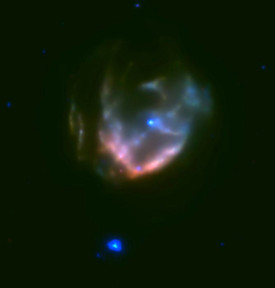The Hot and Energetic Universe
X-ray astronomy is crucial for seeing the Universe as it really is, not as we think it to be.
Traditionally, space has been thought of as a place of serene majesty but X-ray astronomy has shown us the truth: it’s a hot and energetic Universe out there. Even the stars look cool in comparison.
Stars shine with surface temperatures of between 2000 and
Until the middle of the twentieth century, when the first X-ray detectors were launched into space, we were largely blind to the hot and energetic Universe because X-rays do not penetrate the upper atmosphere of our planet. For us to see this realm we must launch X-ray satellites into space.
ESA has been involved in a number of X-ray missions. The European X-ray Observatory Satellite (EXOSAT) was built by ESA and operated from 1983 to 1986, and ESA's space science department was involved in the Italian-Dutch BeppoSax X-ray mission launched in 1996.
 |
| Artist's impression of the XMM-Newton spacecraft. Credit: ESA/D. Ducros |
These forays into X-ray astronomy proved their worth and spurred ESA to develop the cornerstone mission, XMM-Newton. It has operated this X-ray observatory since 1999, and has now made the hot and energetic Universe its science theme for the Cosmic Vision L2 mission opportunity, set for launch in 2028.
In June 2014, the Athena advanced telescope for high-energy astrophysics was selected as the mission concept to explore this theme.
Within the theme, there are two major questions to be answered. First, how does ordinary matter assemble into the large-scale structures we see in the Universe today?
Rewind 13 billion years and the Universe was filled by a more or less smooth distribution of matter. Today, the picture is different. Matter is distributed into filaments that stretch across space, and these are the homes of clusters of galaxies. In-between these filaments, which are sometimes called the cosmic web, are voids. These empty spaces make up more than half of the volume of the Universe.
So the question is: What forces sculpt the Universe from an all but featureless cosmic ocean into a tracery of galaxies and gas clouds.
The visible matter in galaxies is calculated to comprise less than half the atoms in the Universe. Cosmological simulations show that most of it is expected to reside in streamers of hot gas that braid the galaxy filaments. Cosmologists call it the warm-hot intergalactic medium (WHIM), as they calculate its temperature to be between 105 and 107 K.
As yet, however, there has been no convincing detection of the WHIM. Athena will make a large-scale map, providing the first atlas of the warm-hot intergalactic medium.
It is expected that there will be shock waves rippling through the WHIM. The origin of these shock waves leads on to the second question in the theme: How do black holes grow and shape the Universe?
Long characterised in the public eye as 'cosmic destroyers', black holes play a much more nuanced role in shaping the Universe. There is a growing realisation that they can sculpt cosmic structures through the shock waves and the resulting turbulence they create in the surrounding matter.
There is now an unprecedented body of evidence that black holes exist in the Universe. The smallest are formed when stars explode. These are known as the stellar black holes. The largest of the black holes are found at the heart of each and every galaxy. Termed supermassive black holes, they each contain millions or even billions of times the mass of the Sun.
 |
| Artist's impression of a galaxy with outflows and jets. Credit: ESA/AOES Medialab |
Black holes have not yet been observed in the process of formation, so it is impossible to say whether they formed before or simultaneously with their host galaxies. What is certain is that now each supermassive black hole is the single, most massive object in its galaxy. It provides the central gravitational hub around which the rest of the stars and gas orbits.
The influence of these black holes can extend out far beyond even the host galaxy. This is because enormous jets of gas can sometimes form close to the supermassive black hole. It is not fully understood how the jets form but they offer some particles an escape route from destruction.
Any matter that falls into the black hole is to all intents and purposes gone forever. It collects around the black hole in a swirling maelstrom known as an accretion disc. Before it crosses the final threshold to oblivion, a fraction can be diverted away from the jets and sprayed into intergalactic space. Here, these jets will collide with the hot gas surrounding the galaxy, creating shock waves and turbulence. These are the enemy of structure formation as they supply energy to the gas, which then resists the attractive force of gravity that tries to pull the matter together to form galaxies.
This is known as a feedback process and is a largely unquantified component of structure formation in the Universe. To address this, Athena will conduct a census of supermassive black holes in the Universe. It will look for them in the more distant, and therefore the earlier, parts of the Universe.
Athena can then trace the growth of structure with reference to the size and distribution of supermassive black holes in the Universe.
At completely the other end of the size-scale, the hot and energetic Universe can encompass the smaller stellar objects: the collapsars. These are some of the most exotic objects in the whole of space.
The stellar black holes mentioned earlier are just one type of collapsar. Others include neutron stars, which squeeze the mass of the Sun into something the size of an asteroid: about
 |
| XMM-Newton image showing the supernova remnant Kesteven 79 (above) and a magnetar (below). Credit: ESA/XMM-Newton/ Ping Zhou, Nanjing University, China |
X-rays are also produced in large quantities in the aftermath of the supernovae explosions as gaseous debris from the supernova is flung out into space at high velocity. When this collides with other clouds of gas, it forms shock waves that can shine brightly in X-rays. This emission can persist for centuries after the initial explosion.
Normal stars give off X-rays too from the stellar flares that discharge when their magnetic fields reconfigure themselves spontaneously. Orbiting exoplanets may interact with the star and modulate these X-ray emissions.
Athena, the mission concept selected by ESA to investigate the hot and energetic Universe, will represent an invaluable complement to the 'cold matter' astronomy that is practised from ground-based observatories and space telescopes that observe the longer wavelengths such as visible light and infrared radiation.



